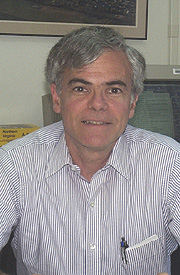
. . . . WE AGREED LAST
DECEMBER THAT A NEW
APPROACH, BASED ON
DEVELOPMENT OF A
DEFINED BUDGET FOR
BOTH DOMETIC AND
FOREIGN TRAVEL TO
SCIENTIFIC MEETINGS,
WOULD SUPERSEDE THE
'RULE OF FIVE' FOR THE
NIH.
| T H E N I H C A T A L Y S T | M A R C H – A P R I L 2002 |
|
|
|
| F R O M | T H E | D E P U T Y | D I R E C T O R | F O R | I N T R A M U R A L | R E S E A R C H |
TRAVEL
TO SCIENTIFIC MEETINGS:
THE ROAD AHEAD
 |
| MICHAEL GOTTESMAN |
|
. . . . WE AGREED LAST DECEMBER THAT A NEW APPROACH, BASED ON DEVELOPMENT OF A DEFINED BUDGET FOR BOTH DOMETIC AND FOREIGN TRAVEL TO SCIENTIFIC MEETINGS, WOULD SUPERSEDE THE 'RULE OF FIVE' FOR THE NIH. |
Other than space and parking, there are few issues so likely to inspire spirited discussion by scientists at NIH than restrictions on travel to scientific meetings. Professional meetings and publications form the core of scientific communication and provide critical opportunities for scientists to present their work and become acquainted with colleagues—something especially important for trainees.
The numerous ways in which scientific meetings contribute to the vitality of modern science and improve efficiency of information transfer were the subjects of a recent white paper written by the Office of Intramural Research to inform the discussion about the importance of meeting travel.
Last year, the Department of Health and Human Services (DHHS), of which NIH is a part, began to review travel to scientific meetings as part of its responsibility to ensure appropriate stewardship of public funds.
To be sure that all scientific meeting travel is essential, the DHHS decided that it had to review and approve travel to meetings any time it involved five or more NIH scientists. This proactive approach to management of travel to scientific meetings created logistics problems for the NIH and DHHS.
After discussions, we agreed last December that a new approach, based on development of a defined budget for both domestic and foreign travel to scientific meetings, would supersede the "rule of five" for the NIH.
Based on needs projected from last year’s budget, NIH prepared a budget for scientific meeting travel for the current fiscal year. That budget was vetted and approved by the DHHS and distributed among our institutes and centers.
The institute budgets were created with an eye to providing enough funds to support essential scientific meeting travel for all intramural and extramural investigators—assuming last year’s average costs for domestic and foreign meetings, with a modest increase for security costs.
Senior investigators would typically travel to more meetings than junior investigators; postdoctoral fellows, graduate students, and some postbacs would be funded for travel to a meeting approved by their supervisors. Trainees who win a competitive $1,000 FARE (Fellows’ Award for Research Excellence; see announcement) will have the opportunity to attend an additional meeting.
To optimize the use of travel funds, there is a premium on finding the least expensive ways to get to meetings and to secure accommodations while there. Funds saved by keeping expenses down will allow for additional essential travel to meetings. Here are some considerations for meeting travel budgets:
![]() Where feasible, car travel and shared rooms make sense.
Where feasible, car travel and shared rooms make sense.
![]() Registration fees do not count against meeting travel ceilings.
Registration fees do not count against meeting travel ceilings.
![]() Check out the December 2001 "News To Use" accessible from its website
for information on securing the most economical travel arrangements (see "NIH
Lowest Airfare Guarantees. . . and Exceptions," beginning on the bottom
of page 4).
Check out the December 2001 "News To Use" accessible from its website
for information on securing the most economical travel arrangements (see "NIH
Lowest Airfare Guarantees. . . and Exceptions," beginning on the bottom
of page 4).
Within each institute and center, travel ceilings will be allocated to laboratories, branches, and programs, or other units of appropriate size to support efficient distribution of funds. Leadership at these levels will determine the optimal use of travel funds, in keeping with the travel needs of scientific staff and trainees.
We believe that planning travel through this approach can work for NIH. Throughout this fiscal year, we will take stock of how this system is working and make adjustments as needed to be sure that essential travel to scientific meetings is supported in the most efficient way.
Deputy Director for Intramural Research